You have ABS so if you do not open the bleed screws before you push the caliper piston back, you can damage the ABS module and that would be an expensive mistake. I recommend that you get some clear plastic tubing from the fish and aquarium department of a department store like Walmart. Cut off a foot or two and loop it upwards from the bleed valve when you open the bleed valve. That will keep air from getting into you brake system.
A large C-clamp, 16" channel lock pliers or that special tool will all work but I would also recommend that you keep the old pad in place over the piston to prevent any damage to the piston.
When you are done, it would be a good time to flush and bleed the brake system. After finishing the brake pads, use a suction tool (turkey baster etc) to draw out most of the brake fluid in the master cylinder, then refill with fresh. Then put a foot or two of that tubing on each bleeder valve, looped upward and then into a container. Open every brake bleeder and let the fluid flow, keeping the master cylinder full while doing this until the fluid is clear coming out the bleeders. You can close each bleeder as the fluid becomes clear.
When all four calipers are clear, top off the master cylinder to the "TOP" line and test the brakes. After a couple of pushes on the brake pedal to get the brake pads adjusted to the rotors, they should firm up. No additional bleeding should be necessary as long as you didn't get any air into the system. If they are soft, you will need to do the bleed procedure.
Edit: one more thing, while the pads are out, make sure the calipers slide easily on the caliper pins. If they do not, then you will need to get a seal kit for the caliper pins, clean them, lubricate them with silicone or synthetic grease and put in the new seals. If those calipers don't slide freely, your outer pads will wear out quickly, very quickly, like in just a month or two.





